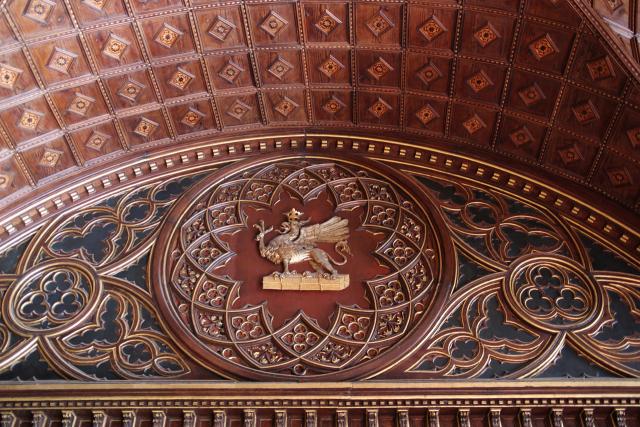Wooden furnishings in Audience hall
The Merchants Guildhall

The Sala dell’Udienza della Mercanzia (Merchants Audience hall) is unique in its genre in Italy. The use of wooden panelling to line the hall walls was rare in a lay premises; more usually being reserved for choir stalls and sacristies. A variety of factors may have contributed to the decision to have the hall decorated by master woodworkers rather than fresco painters: The Merchants Guild wanted to bestow a matchless atmosphere on its two chambers; the place of business needed to comfortable and, given that Perugian winters could be harsh during the Little Ice Age, wooden furnishings (popular in Northern Europe) would make the space more liveable, an ostentatious projection of wealth may also have been desirable.
Using precious woods, employing master woodworkers and also the lengthy lead time required to create such a complex and refined environment made the decoration work much more expensive than simply having frescoes painted. Although there are no authoritative archival records to confirm the craftsmen and execution dates it seems likely that the wooden furnishings for the walls and vaulting were created between 1390 and 1403. What can be established is that the work was completed before 1440, the date of the painting formerly presumed to be by Mariano d’Antonio (now attributed to Maestro dell’Annunciazione Campana and on display in Museo Jacquemart-André in Paris) which was hung in the Collegio chambers to complete their decoration.
The Grifo passante sulla balla di lana (Gryphon treading a skein of wool) framed by Gothic motifs and symbolising art stands out on the right-hand wall. The uniform wooden panelling repeats, ad infinitum, the same motif (a glyph or ottonario: a polygonal superimposition of two semi-rotated quadrants with eight points) inscribed with a quatrefoil: an Oriental theme with roots in Persia or India which was widely adopted in Islamic art and later spread around the Mediterranean.